Please report any broken links or trouble you might come across to the Webmaster.
Please take a moment to let us know so that we can correct any problems and make your visit as enjoyable and as informative as possible.
| Click On Image For Full Size | Size | Image Description | Source | |
|---|---|---|---|---|
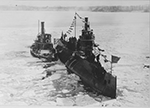 |
457k | Launching of the O-8 (SS-69), 31 December 1917. | National Archives Identifier: 45547168 Local Identifier: 165-WW-499A-18. Photo courtesy of catalog.archives.gov | |
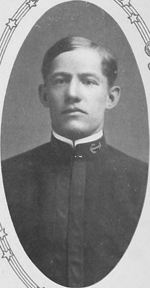 0806919 |
148k | O-8 (SS-69) Sponsor: Mrs. Robert A. Burg (Alice Claire), wife of Lieutenant R. A. Burg, U. S. Navy, prospective commanding officer. She was camera shy. He was killed in a aviation accident in England in 1925 while serving as an attache to the embassy there. |
Text from Ships of the United States Navy and Their Sponsors, pg. 159. Photo courtesy of usnamemorialhall.org | |
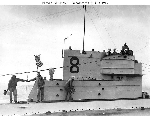 |
67k | Crew members standing in and by the O-8's (SS-69) fairwater, while she was with the "Victory Fleet" off New York City in 1919. | US Naval Historical Center photo # NH 44553. | |
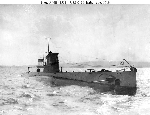 |
47k | O-8 (SS-69) in a harbor, circa 1919. | US Naval Historical Center photo # NH 44554. | |
 |
56k | Savannah (ID-3015) with O-boats alongside, circa 1919. O-6 (SS-67), is outboard at Savannah's bow, and O-8 (SS-69) is outboard at her stern. | USN photo # 98630 courtesy of Jim Kazalis, 1981. From the collections of the US Naval Historical Center | |
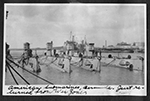 |
579k | U.S. submarines at Bermuda. Just returned from war zone. From left to right, 2 unidentified O-boats, O-3 (SS-64), O-5 (SS-66) & O-7 (SS-68). On 2 November 1918 O-boats 1 / 10 (SS-62 / 71) departed Newport with a 20-sub contingent bound for European waters, however, the Armistice was signed before the ships reached the Azores, and they returned to the United States. |
Text i.d. courtesy of DANFS. Photo by James W. Anderson, courtesy of Kristina Magill via Gary Priolo. |
|
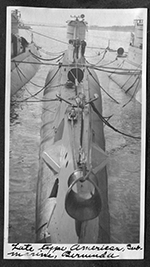 |
1.04k | Late type American submarine, Bermuda. One of the unknown 10 O-boats 1 / 10 (SS-62 / 71) . | Photo by James W. Anderson, courtesy of Kristina Magill via Gary Priolo. | |
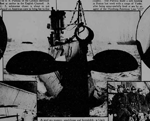 |
659k | A steel sea monster, amphibious and formidable, is Uncle Sam's newest submarine just home from war duty. The great fin rudders stabilize the boat under water and assist in speedy submerging. They fold up snugly against the sides when the "sub." is under way. Several of these new O-boats are making their initial New York appearance in the Naval Review. | Image provided by: Library of Congress, Washington, DC. Photo from the New-York Tribune. (New York [N.Y.]) 1866-1924, 27 April 1919, Image 47, via chroniclingamerica.loc.gov. |
|
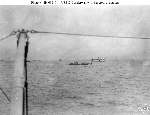 |
59k | O-8 (SS-69) underway with her crew at quarters on deck, circa the early 1920s. | US Naval Historical Center photo # NH 61819. Courtesy of the San Francisco Maritime Museum, San Francisco, California. | |
 |
69k | Chief Gunner's Mate David J. Lohr (right) and Chief Machinist's Mate Hadley pose by the breech of O-8's (SS-69) retractable 3"/23 gun, circa 1920. Lohr's original caption reads: "Ever see a real tough looking hombre? If I look like this I'd better start wearing a mask." | US Naval Historical Center photo # NH 101000. Copied from the collection of David J. Lohr, by courtesy of Radioman 1st Class Pamela J. Boyer, USN, 1986. | |
 |
59k | Chief Gunner's Mate David J. Lohr (right) and a friend posing on deck, by the O-8's (SS-69) retractable 3"/23 gun, circa 1920. Lohr's original caption reads: "I like this one best. The pose is so natural. The other lad is 'Jimmie O-8' also from Chicago." | US Naval Historical Center photo # NH 101001. Copied from the collection of David J. Lohr, by courtesy of Radioman 1st Class Pamela J. Boyer, USN, 1986. | |
 |
58k | Submarine Base, New London,at Groton, Connecticut. Seen from on board an approaching submarine, probably O-8 (SS-69), in October 1920. Note the submarine's open forward hatch cover. | US Naval Historical Center photo # NH 101002. Copied from the collection of David J. Lohr, by courtesy of Radioman 1st Class Pamela J. Boyer, USN, 1986. | |
 |
85k | Submarine Division 8,Commander Guy E. Davis commanding. Nine of the Division's ten O-boats at the Boston Navy Yard, Charlestown, Massachusetts, 16 August 1921. Panoramic photograph by Crosby, "Naval Photographer", 11 Portland Street, Boston. Submarines in the front row are (from left to right): O-3 (SS-64), O-6 (SS-67), O-9 (SS-70) and O-1 (SS-62). Those in the second row are (from left to right): O-7 (SS-68), unidentified (either O-2 or O-8), O-5 (SS-66), O-10 (SS-71) and O-4 (SS-65). Large four-stacked ship in the left center distance is the U.S. Army Transport Mount Vernon. | USNHC photograph # NH 103193. | |
 |
800k | GERMAN MOTHER OF U.S. SUBS The Saxonia, now Savannah (AS-8), once considered the finest German passenger ship, is now a mother for United States submarines. Here she is off the coast at Provincetown, Mass., with some of her cubs. |
Image and text provided by Arizona State Library, Archives and Public Records; Phoenix, AZ. Photo from the Bisbee Daily Review. (Bisbee, Ariz.) 1901-1971, 21 August 1921, SECOND SECTION, Image 9, via chroniclingamerica.loc.gov. |
|
 |
113k | Broadside view of the O-8 (SS-69), probably off Coco Solo, C.Z. in 1924. | USN photo courtesy of CTM Russel Rau, former COB of Wahoo SS-238, submitted by Bill Rau & Paul Crozier. | |
 0806917 | 484k | 3 O-boats bows: Broadside view of O-8 (SS-69) with two other unidentified O-boats moored to a buoy in Gatun Lake, Panama, approximately 1925. The famous Gatun Dam can be seen in the background, with the hydroelectric power station building on the right. The dam is the centerpiece of the canal, providing water for the 21 mile long lake as well as for the majority of the rest of the canal. It also provides power to operate the locks as well as for the needs of the surrounding population. | Photo i.d. & text courtesy of David Johnston (USN, retired) USN photo thanks to Jim Kurrasch @ Battleship Iowa, Pacific Battleship Center. | |
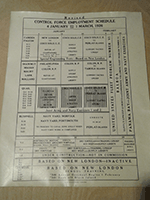 |
1.72k | Control Force Employment Schedule, 4 January to 1 March 1926. US Fleet Problem Number VI. | Photo courtesy of Steve Ireland. | |
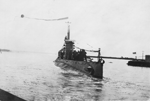 |
487k | O-8 (SS-69) arriving in port, circa 1927. | Photo scanned by Bill Faulk from an original in his collection, courtesy of Robert Hurst. | |
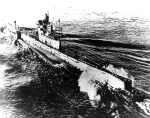 |
242k | The O-boats (SS-62/77) were the oldest U.S. submarines retained for use during WW II. O-8 (SS-69) is shown here. The most obvious modification was the addition of a small platform for a light anti-aircraft gun abaft the bridge. Like other E.B.("Holland") O-boats, R-boats (SS-78/104) & S-boats (SS-105/46 - 153/162), O-8 was modified for greater safety: It's skeg superstructure was cut down aft to clear a new escape hatch in her motor room. The object right aft is a messenger buoy. Note the JK passive sonar transducer forward. |
Text courtesy of U.S. Submarines Through 1945, An Illustrated Design History by Norman Friedman. Naval Institute Press. USN photo courtesy of ussubvetsofwwii.org. | |
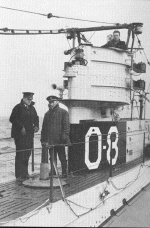 |
47k | The object on the deck of the O-8 (SS-69) that the men are standing around is the 3"/23 deck gun retracted into its below deck housing in a vertical position as shown here. | USN photo courtesy of Ric Hedman / rddesign@rddesigns.com | |
 |
67k | These O type and S type submarines which were used during the World War have since been decommissioned and are now laid up in the Phila. Navy Yard. The peaceful surroundings are quite a contrast to those of their active war days. They are pictured here on 17 July 1936. The S-10 (SS-115) was decommissioned on the day this photo was taken at Philadelphia Navy Yard, Philadelphia, PA. and laid up in the Reserve Fleet. Pictured also are any of the following boats that were at the PNY during this time. The O boats: O-1 (SS-62), O-2 (SS-63), O-3 (SS-64), O-6 (SS-67), O-7 (SS-68), O-8 (SS-69), O-9 (SS-70), O-10 (SS-71). The S boats: S-6 (SS-111), S-7 (SS-112), S-8 (SS-113), S-9 (SS-114), S-11 (SS-116), S-12 (SS-117), S-13 (SS-118), S-14 (SS-119), S-15 (SS-120), S-16 (SS-121), S-17 (SS-122) & S-48 (SS-159). |
Photo & text courtesy of A.P. Wire courtesy of philly.com. | |
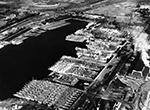 |
2.49k | Philadelphia Navy Yard, 28 October 1940. The photo presented panorama military shipyards in Philadelphia Navy Yard. Most of the ships are obsolete US destroyers, that were transfer to Great Britain under lend lease. The submarines are on the left hand side of the photo, and they are: (in no particular order) The O boats:O-1 (SS-62), O-2 (SS-63), O-3 (SS-64), O-6 (SS-67), O-7 (SS-68), O-8 (SS-69), O-9 (SS-70), O-10 (SS-71). The R boats: R-1 (SS-78), R-2 (SS-79), R-3 (SS-80), R-5 (SS-82), R-6 (SS-83), R-7 (SS-84), R-8 (SS-85), R-9 (SS-86), R-10 (SS-87), R-12 (SS-89), R-15 (SS-92), R-16 (SS-93), R-17 (SS-94), R-18 (SS-95), R-19 (SS-96) & R-20 (SS-97). The S boats: S-11 (SS-116), S-12 (SS-117), S-13 (SS-118), S-14 (SS-119), S-15 (SS-120), S-16 (SS-121), S-17 (SS-122) & S-48 (SS-159). The Olympia (C-6) is shown at the right of the wharf on Broad Street. The stadium in the upper left, was John F. Kennedy Stadium (formally Philadelphia Municipal Stadium) that stood from 1926 to 1992. It was erected for the 1926 Sesquicentennial. |
Photo i.d. courtesy of Ron Reeves (of blessed memory). Photo courtesy of flickr.com. Lower resolution photo. (548k) |
|
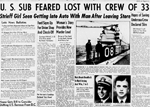 0806918 | NR | PORTSMOUTH. N. H — SISTER SHIP OF MISSING SUB. The submarine O-8 (SS-69) pictured above, accompanied the submarine O-9 (SS-70) on the trial run from which the latter was reported overdue today. The two submarines are of similar type. The O-8 is shown during a demonstration run near the submarine base at New London, Conn., with a radio announcer, George Hicks, in the conning tower. Lt. C. M. Momsen (left), inventor of the famed escape lung, and Lt. George C. Hern are on deck. | A. P. Wirephoto Image provided by: Library of Congress, Washington, DC. Photo from the Evening Star.[volume] (Washington, D.C.) 1854-1972, 20 June 1941, Image 1, via chroniclingamerica.loc.gov. |
|
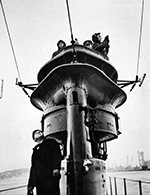 |
1.02k | O-8 (SS-69), 1942. These Men Are In Training For Life On A U.S. Submarine. The modern submarine is playing a big part in the war on the seas. Its quarry is all of the enemy's navy but its aircraft. It seeks convoys and unprotected merchant ships, harries fleets, and sometimes engages in deadly underwater duels with others of its own kind. Among the world's navies, U.S. submarines are considered supreme. One reason for this supremacy is the strenuous training of their crews. The training, shown in this set of 18 pictures, is given the submarine candidate at U.S. Navy's Submarine School at New London, Connecticut, in the northeastern section of the United States. Shown: On surface, these officers of the training submarine check the craft's bearings from the conning tower. Office of War Information Photograph, April 22-28, 1942. |
Photo Lot-9434-28. Office of War Information Photograph, courtesy of the Library of Congress, from the National Museum of the U.S. Navy, courtesy of flickr.com. | |
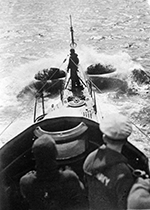 |
1.25k | Spray washes over the bow as submarine trainer, with New London students aboard, takes to the sea for a cruise. | Photo Lot-9434-29. Office of War Information Photograph, courtesy of the Library of Congress, from the National Museum of the U.S. Navy, courtesy of flickr.com. | |
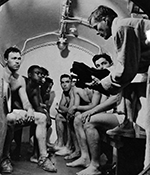 |
640k | In the pressure chamber, all candidates accepted for submarine service receive their preliminary test for underwater fitness. In order to pass it, they must spend about 23 minutes undergoing 50 pounds of pressure. This is equivalent to a sea depth of more than 100 feet. An instructor, (at right), is observing their reactions to the pressure. | Photo Lot-9434-22. Office of War Information Photograph, courtesy of the Library of Congress, from the National Museum of the U.S. Navy, courtesy of flickr.com. | |
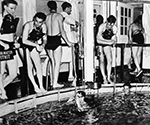 |
753k | To conquer the terror of deep waters, the students descend to various levels of a 138-foot tower containing 100 feet of water. From the successively deep levels, using an oxygen-supplying Momsen Lung to breathe, they float up to the top. | Photo Lot-9434-23. Office of War Information Photograph, courtesy of the Library of Congress, from the National Museum of the U.S. Navy, courtesy of flickr.com. | |
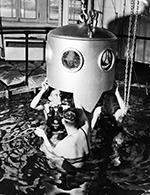 |
1.21k | Having learned to use the Momsen Lung, the students are now ready to descend to the various water levels. They go down in this heavy diving bell. | Photo Lot-9434-30. Office of War Information Photograph, courtesy of the Library of Congress, from the National Museum of the U.S. Navy, courtesy of flickr.com. | |
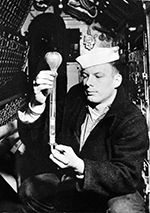 |
1.31k | An electrician checks the batteries which power the submarine underwater. Batteries make up one-fifth of the boat's weight. | Photo Lot-9434-27. Office of War Information Photograph, courtesy of the Library of Congress, from the National Museum of the U.S. Navy, courtesy of flickr.com. | |
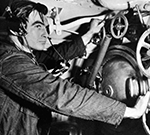 |
1.09k | A torpedoman stands on the alert at one of the forward torpedo tubes. "Water slugs" powered by compressed air are fired in practice attacks. | Photo Lot-9434-26. Office of War Information Photograph, courtesy of the Library of Congress, from the National Museum of the U.S. Navy, courtesy of flickr.com. | |
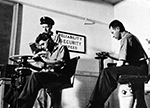 |
978k | Here, a group of students is learning to operate the submarine's hydrophones. | Photo Lot-9434-26. Office of War Information Photograph, courtesy of the Library of Congress, from the National Museum of the U.S. Navy, courtesy of flickr.com. | |
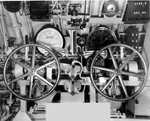 |
89k | Diving station aboard the O-8 (SS-69), 1942. | Photographer: probably Dimitri Kessel, courtesy of Life. Photo courtesy of John Hummel, USN (Retired). |
|
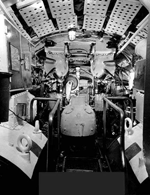 |
127k | Aft motor rooom aboard the O-8 (SS-69), 1942. | Photographer: probably Dimitri Kessel, courtesy of Life. Photo courtesy of John Hummel, USN (Retired). |
|
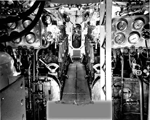 |
118k | Aft engine room aboard the O-8 (SS-69), 1942. | Photographer: probably Dimitri Kessel, courtesy of Life. Photo courtesy of John Hummel, USN (Retired). |
|
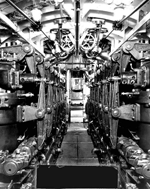 |
132k | Forward engine room aboard the O-8 (SS-69), 1942. Folding table can be seen thru door. | Photographer: probably Dimitri Kessel courtesy of Life. Photo courtesy of John Hummel, USN (Retired). |
|
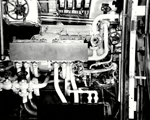 |
379k | O-8 (SS-69) trim manifold, 1942. | Photographer: probably Dimitri Kessel. USN photo courtesy of Scott Koen & ussnewyork.com | |
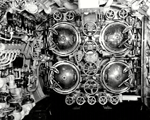 |
520k | O-8 (SS-69) torpedo room, 1942. | Photographer: probably Dimitri Kessel. USN photo courtesy of Scott Koen & ussnewyork.com | |
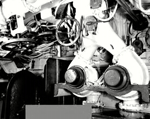 |
420k | O-8 (SS-69) forward battery, 1942. | Photographer: probably Dimitri Kessel. USN photo courtesy of Scott Koen & ussnewyork.com | |
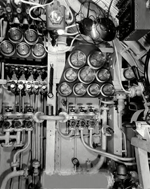 |
643k | O-8 (SS-69) high pressure air manifold, 1942. | Photographer: probably Dimitri Kessel. USN photo courtesy of Scott Koen & ussnewyork.com | |
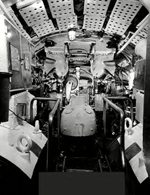 |
585k | O-8 (SS-69) motor room, 1942. | Photographer: probably Dimitri Kessel. USN photo courtesy of Scott Koen & ussnewyork.com | |
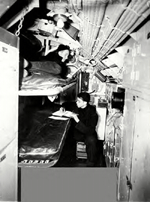 |
341k | Bunking on O-8 (SS-69). | Photographer: probably Dimitri Kessel. USN photo courtesy of Scott Koen & ussnewyork.com | |
 |
241k | Warm scenery for the O-8 (SS-69). | Photographer: probably Dimitri Kessel. USN photo courtesy of Scott Koen & ussnewyork.com | |
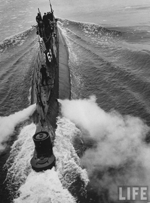 |
195k | O-8 (SS-69) underway and about to submerge off of New London, CT in 1942. "It was from O-8 that a radio program was broadcast from under water. Two NBC announcers, one located in the main control room of the submarine, and another situated in the torpedo room, described their sensations as the sub made its descent to the bottom of the sea." (quoted from the original mid-1920s vintage caption). |
Text courtesy of US Naval Historical Center photo # NH 69038. Photographer: Dimitri Kessel courtesy of Life. | |
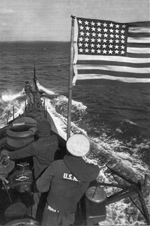 |
371k | Homeward Bound O-8 (SS-69) returns to home base at New London CT., after a training cruise in 1942. |
USN photo probably by Dimitri Kessel, from the NMMA collection, courtesy of Mike Brock. | |
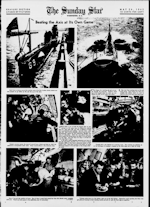 |
NR | Beating the Axis at Its Own Game! The O-8 (SS-69) appears here in at least one photo, if not more. |
Image and text provided by Library of Congress, Washington, DC. Photo & text by Evening Star. [volume] (Washington, D.C.) 1854-1972, 24 May 1942, Image 104, courtesy of chroniclingamerica.loc.gov. | |
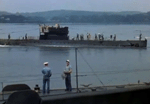 |
189k | A scene from the 1943 movie Crash Dive, showing an unidentified O-class submarine backing out of a berth at the Naval Submarine Base New London, CT in the late summer of 1942. The boat can not be positively identified, but is one of group of eight O-class submarines that were brought out of mothballs to train submarine crews. This particular boat is either O-2 (SS-63),O-3 (SS-64), O-4 (SS-65), O-7 (SS-68), O-8 (SS-69), or O-10 (SS-71). The submarine in the foreground is the Marlin (SS-205). | Photo & text courtesy of David Johnston | |
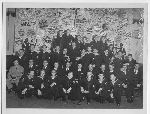 |
58k | Skippers Birthday Party held at Peggy's Inn, Norwich CT, in 1945. | USN photo courtesy of Clem O'Brien & submitted by Sean O'Brien. | |
| Back To The Main Photo Index | Back To the Submarine Index |
|
Problems and site related matters, E-mail Webmaster |
|
This page is created by Gary Priolo and maintained by Michael Mohl All Pages © 1996 - 2024 NavSource History |